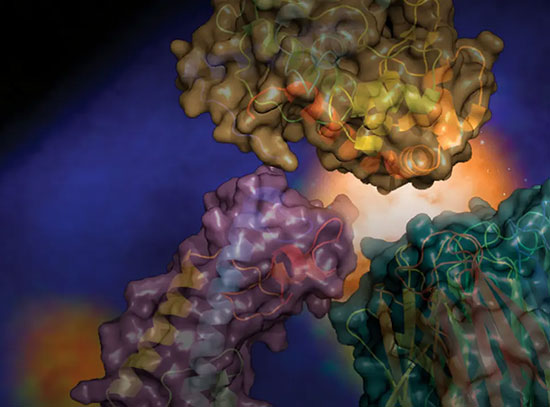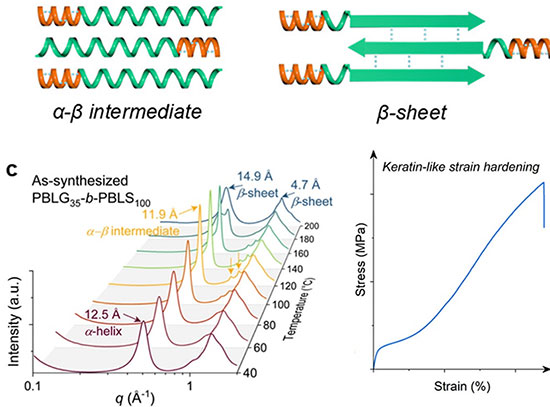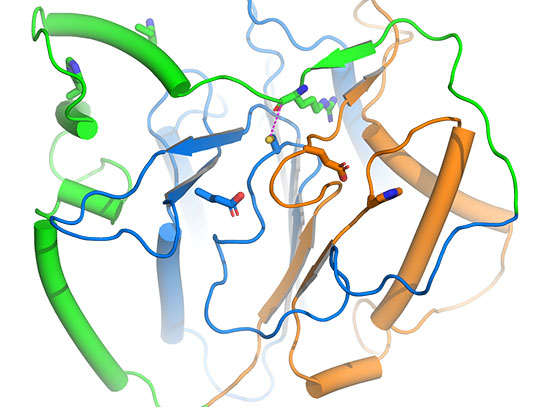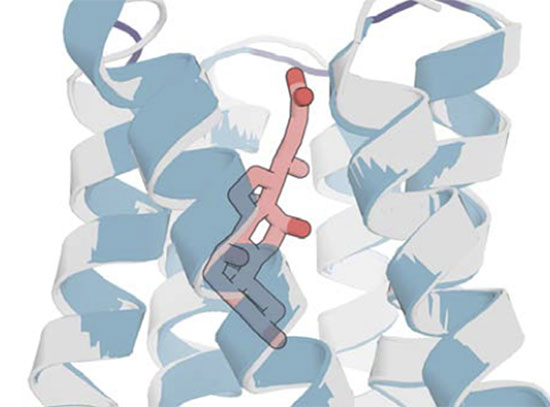Exploring and understanding our planet and its life
The Center for BioMolecular Structures (CBMS) studies life at its smallest and largest scales, from the behavior of its molecular building blocks to their influence on Earth’s environment. The CBMS offers a research environment that allows visiting researchers, partners, and collaborators to succeed in their hypothesis-driven research by combining staff expertise with a multitude of advanced research tools.
The Center is embedded in the National Synchrotron Light Source II (NSLS-II), a state-of-the-art synchrotron light source located at the U.S. Department of Energy’s (DOE) Brookhaven National Laboratory and adjacent to the Laboratory of BioMolecular Structure (LBMS), an advanced cryo-electron microscopy center.
Contacts
-

Sean McSweeney
(631) 344-4506, smcsweeney@bnl.gov
-

Vivian Stojanoff
(631) 344-8375, stojanof@bnl.gov
Announcements
See allEvents
- JUL30Wednesday
CBMS Lecture Series
Location of surface waters reveals how antifreeze and ice nucleation proteins work
Peter Davies, Queen's University, Canada
Wednesday, July 30, 2025, 1:30 p.m., Videoconference / Virtual Event
- AUG6Wednesday
CBMS 101 Training - autoProc
autoProc: What does it tell you about your data
Steven Sheriff, Princeton University
Wednesday, August 6, 2025, 1 p.m., Videoconference / Virtual Event
- OCT9Thursday
82th Pittsburgh Diffraction Conference
TBA
TBA, TBA
Thursday, October 9, 2025, 8 a.m., Wang Center Stony Brook
- OCT12Sunday
Center for Biomolecular Structure Lecture Series
Macromolecular Crystallography Course @ CSHL
Sunday, October 12, 2025, 9 a.m., Cold Spring Harbor Laboratory
Become a User
Experimental time or beam time at all beamlines and experimental stations at NSLS-II is available at no charge to researchers and it is granted through a peer-review proposal process. Proprietary access is also available at a full cost-recovery rate.
For detailed information on how to become a user, see the NSLS-II Users’ Guide. More information on access modes to all beamlines.
Become a Partner
CBMS considers partnerships and collaborations one of its highest values, and offers tailored opportunities for partnerships to conduct complex multi-disciplinary investigations and development of experimental stations.
For more information on a potential partnership, please contact CBMS Director Sean McSweeney, (631) 344-4506.
Education, Outreach, and Training
CBMS will offer a wide range of education and training opportunities on all its experimental tools. The training opportunities will range from day-to-day coaching, assistance in sample preparation, and data collection.
Research Areas
CBMS addresses a wide range of environmental and life science questions by operating a suite of experimental facilities. We support research in all biology-related or environmental studies with a major focus on the following areas:
Bio Physical, Chemical, and Medical Sciences
Understanding the function of biological molecules requires knowledge of their molecular structure. This knowledge has a wide impact on our understanding of disease mechanisms and the design of new drugs and therapies. CBMS focuses on both animal and plant kingdoms in this line of research.
Plant Science
Plants are part of our daily lives, serving as climate and environmental regulators, as well as sources of food and energy. CBMS seeks to understand the fundamental pathways within plants and their cell structure, plants’ usage as bioremediators for various contaminations, and the origin of various plant diseases.
Cell and Tissue Analysis
The analysis of cells and tissues provides a broad range of information that can range from tumor development to functions of subcellular organelles. Understanding fundamental functions impacts mankind’s ability to develop targeted drugs for infections and diseases in the animal or plant kingdoms.
Environmental Chemistry
Atmospheric science focuses on the interactions of Earth’ atmosphere with all its bodies of water, their role in climate change, and the effect on geological formations. Understanding changes throughout time enhances our ability to predict their social, economic, and environmental impact.
Expertise and Capabilities
To support this diverse portfolio of environmental and life science studies, we created and continue to develop a suite of advanced research capabilities. Additionally to these research tools, the center also has expert staff that supports a multitude of research fields through multidisciplinary investigations. Learn more about both research capabilities and expertise:
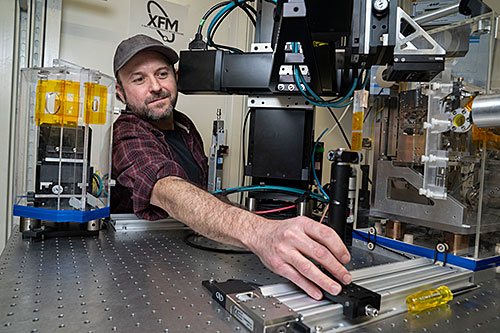
X-ray Bioimaging
To study the elemental distribution and the complex chemistry within biological and environmental samples, we partially develop and operate a suite of experimental stations within NSLS-II's Imaging and Microscopy Program. The program offers specialized tools to investigate the morphology, structure, chemistry, elemental variations, and strain distribution in heterogeneous samples. For more information on the Imaging and Microscopy Program and its contribution to environmental and life science studies within the Program, see the program’s website.
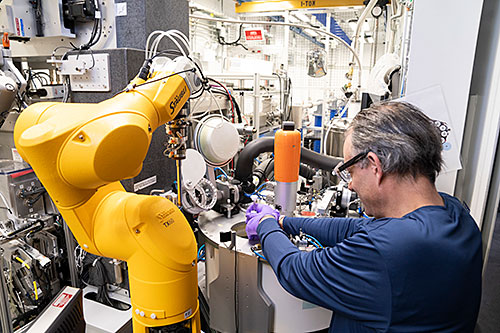
Macromolecular Crystallography
We develop and operate a dedicated suite of Macromolecular Crystallography (MX) beamlines at NSLS-II for discovery-class research on the molecular structure and function of complex biomolecules using extremely small crystals. This selection of research tools offers visiting researchers the ability to study the 3-D structure of crystalized molecule complexes using extremely bright x-rays. For more details on each experimental stations, or beamlines, visit the Structural Biology website.
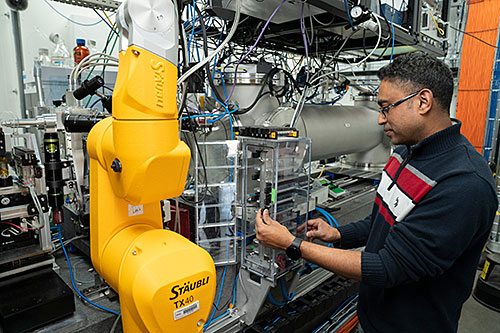
X-ray Scattering on biological and environmental samples
To address fundamental questions in structural biology, as well as cell and tissue research, we offer a dedicated x-ray scattering beamline. This beamline enables visiting researchers to study biological molecules in their native environment and to image cells and tissues using a small x-ray beam and high-end detectors. For more details on each experimental station, see the Structural Biology website.
Partner Facility: The Laboratory of BioMolecular Structure
The Laboratory of BioMolecular Structure (LBMS) at Brookhaven Lab is a cryo-electron microscope center whose mission is to dramatically accelerate our understanding of processes underlying diseases and fundamental molecular structures—knowledge that will lead to faster and more effective treatments. The laboratory is located next door to CBMS’s x-ray imaging and structural biology capabilities, which enables us to share resources and expertise across both facilities. LBMS offers high-resolution data collection for single particle work, molecular tomography electron microscopy, and cellular tomography electron microscopy.
Additional Resources for Visiting Researchers
Visit the Department of Energy (DOE) Biological and Environmental Research (BER) program's Structural Biology and Imaging Resources at Synchrotron Light and Neutron Facilities website for more information on how to access a portfolio of research technologies, methodologies, and instruments.
BER advances fundamental research and scientific user facilities to support DOE’s missions in scientific discovery and innovation, energy security, and environmental responsibility. BER seeks to understand the biological, biogeochemical, and physical principles needed to predict a continuum of processes occurring across scales, from molecular and genomics-controlled mechanisms at the smallest scales to environmental and Earth system change at the largest scales.


The Center for BioMolecular Structure (CBMS) is primarily supported by the National Institutes of Health, National Institute of General Medical Sciences (NIGMS) through Grant # P30GM133893, and by the DOE Office of Biological and Environmental Research FWP # BO070. As part of NSLS-II, a national user facility at Brookhaven National Laboratory, work performed at the CBMS is supported in part by the U.S. Department of Energy, Office of Science, Office of Basic Energy Sciences Program under contract number and DE-SC0012704.




